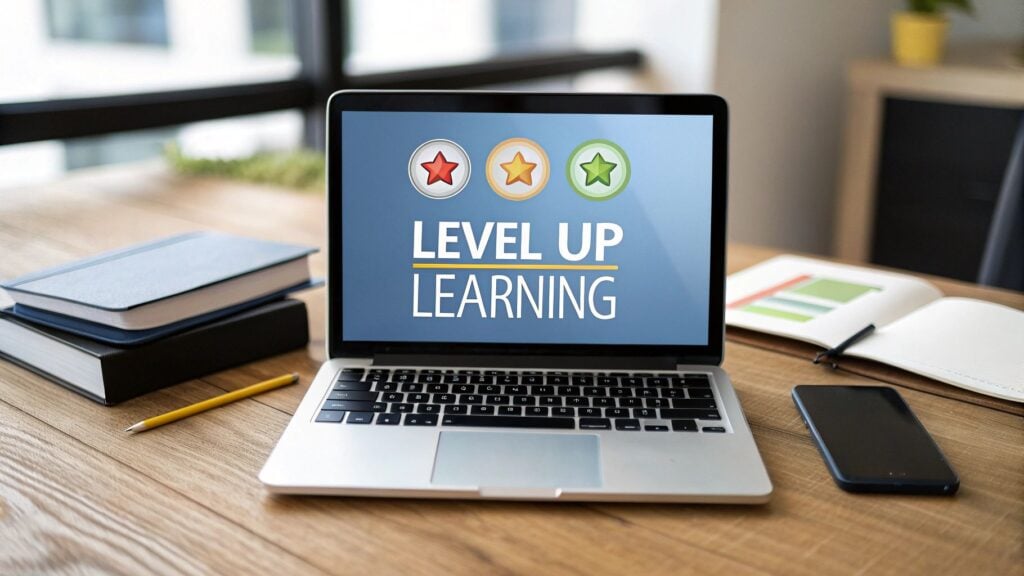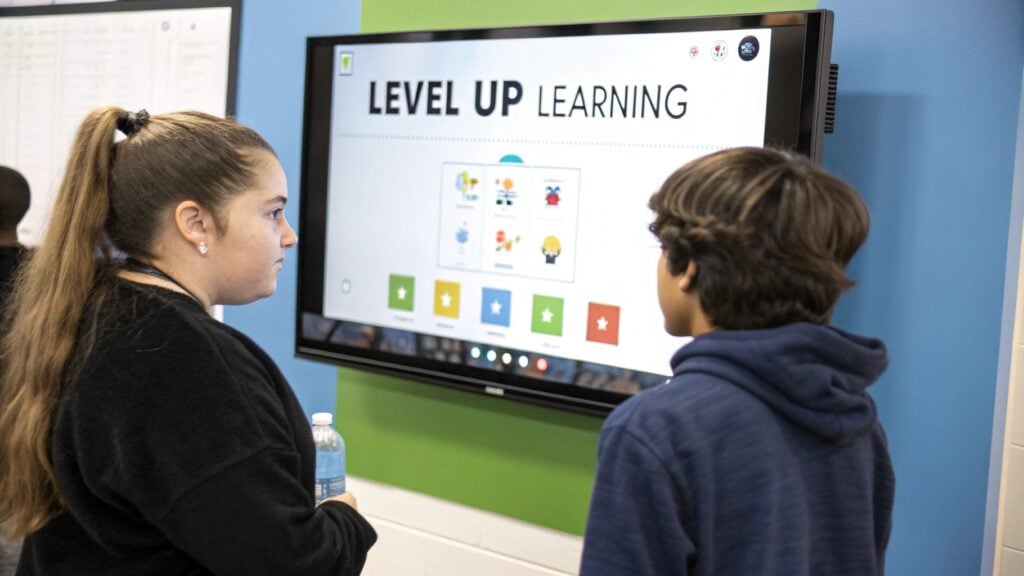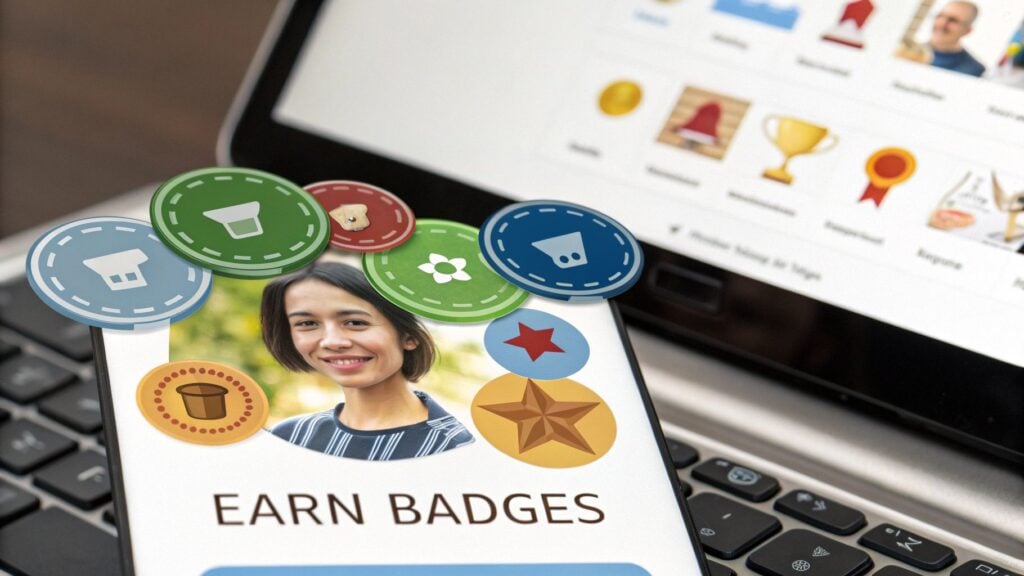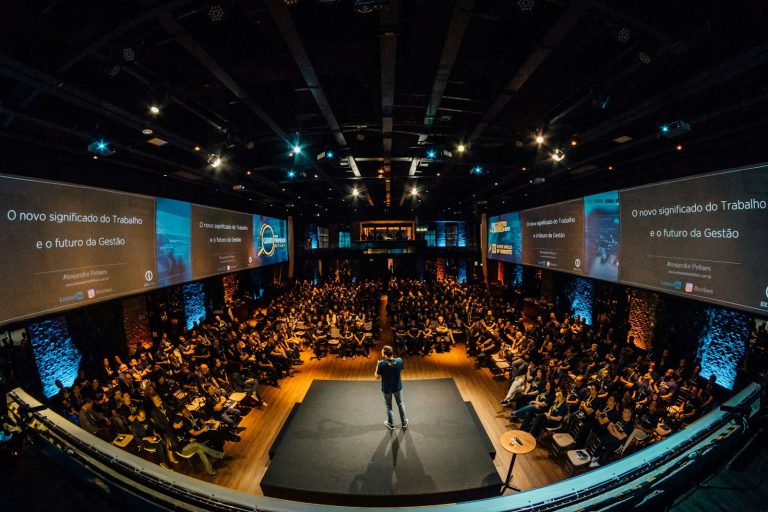Gamification for eLearning That Actually Works

When people hear about gamification for eLearning, their minds often jump straight to flashy video games or complex, animated simulations. The reality is much simpler, and frankly, much more practical. We’re borrowing the most engaging elements from games and weaving them into learning content to make it stick.
So, What Is Gamification for eLearning Anyway?
You know a fitness app uses daily goals and achievement streaks to keep you motivated to exercise? That’s precisely what we’re talking about, but for training modules and online courses.
We’re simply taking the proven psychological triggers that make games so captivating, like points, badges, and leaderboards, and using them to boost learner engagement, or at least trying to. The idea is to transform a task, like a mandatory compliance course, from a chore into an accomplishment.
Gamification for elearning works, when done correctly, because it taps into fundamental human desires we all share:
- Achievement: Earning points or badges delivers a tangible sense of getting something done.
- Competition: A little friendly rivalry on a leaderboard can push learners to bring their A-game.
- Progress: Watching a progress bar fill up is a simple, powerful visual cue that you’re moving forward.
- Community: Team-based challenges encourage collaboration and create a sense of shared purpose.
But if it’s not clear yet, let me break it down a little further.
Gamification Core Concepts Explained
| What Gamification IS | What Gamification IS NOT |
|---|---|
| Applying game mechanics (points, levels, badges) to non-game contexts. | Building a full-fledged video game from scratch. |
| Strategically motivating learners to achieve specific learning outcomes. | Adding fun elements just for entertainment, without a clear purpose. |
| A system to enhance engagement and encourage desired behaviors. | A replacement for solid instructional design and quality content. |
| A way to provide instant feedback and a clear sense of progress. | A “one-size-fits-all” solution for every learning challenge. |
Understanding the distinctions in the table is the key to getting it right. It’s about strategic motivation, not just entertainment. Don wrong, and you sort of screw yourself and annoy the learner.
More Than Just a Game
A common myth I hear is that gamification is only suitable for fun, lighthearted topics. That’s just not true. When designed thoughtfully, it can make even the driest subjects, like data security protocols or financial regulations, easier to understand.
It all comes down to how you build the learning experience.
The game elements must support your learning objectives, not distract from them. For this to work, your gamification strategy has to be built on solid instructional design models for e-learning.
And this approach is gaining serious traction for a reason. The global gamification market is exploding, growing from $9.1 billion in 2020 to a projected $30.7 billion by 2025. This kind of growth doesn’t happen by accident. It shows that companies are seeing real results and investing heavily in these strategies.
The core idea is to make learning an active experience rather than a passive one. When learners are actively involved, they’re far more likely to absorb, retain, and apply the information.
The infographic below shows some hard numbers behind the impact gamification can have on key learning metrics.
When you get the foundation right, you create a learning environment where people are genuinely eager to participate. You create a clear path for learners, reward their progress, and make them feel empowered along the way.
Why Adding Game Mechanics to Learning Works
So, what’s the secret sauce here?
Gamification in elearning is effective because it speaks directly to our natural drives for achievement, a bit of healthy competition, and getting a nod for a job well done.

When we play a game, our brains release dopamine, the chemical messenger tied to pleasure and motivation. This creates a powerful and positive feedback loop. We nail a challenge, feel a rush of satisfaction, and immediately want to do it again. That exact same principle can be applied directly to learning.
This entire process is powered by two distinct types of motivation. A truly smart gamification strategy knows how to pull levers on both.
The Power of Intrinsic and Extrinsic Motivation
First up is extrinsic motivation, the kind that comes from outside rewards.
Think of things like racking up points, unlocking a shiny new badge, or even winning a prize. These are tangible pats on the back that confirm you’ve successfully completed a task. They’re effective because they give you clear, immediate validation for your effort.
But then there’s intrinsic motivation, which is the deep-down drive that comes from within. This is the genuine personal satisfaction you get from finally mastering a new skill or having that “aha!” moment with a complex topic. It’s the feeling of real accomplishment.
A well-designed gamified learning system often uses extrinsic rewards to get learners in the door and engaged. But its ultimate goal is to foster a deeper, more sustainable intrinsic motivation.
The best gamified experiences make learners want to learn, not just feel like they have to.
For instance, earning a “Negotiation Pro” badge is meant to represent the confidence that learner has built and their newfound ability to apply those skills on the job. And that’s where the magic beings to happen.
Tangible Benefits Beyond Just Fun
Research shows that employees who go through gamified training feel dramatically more motivated. In fact, a survey by TalentLMS found that 83% of learners report feeling motivated with gamified training, a stark contrast to just 28% in non-gamified environments.
Here are the key benefits you can realistically expect:
- Higher Course Completion Rates: When learners can clearly see their progress and have well-defined goals, they are far more likely to stick with a course until the end. That little progress bar inching its way toward 100% is a surprisingly powerful motivator.
- Better Knowledge Retention: We remember what we do, not just what we read. Interactive challenges and instant feedback help anchor new information in our long-term memory. When you have to actively apply what you’re learning to solve a problem in a gamified scenario, it sticks.
- A More Positive Attitude Toward Training: Let’s be honest, mandatory corporate training often feels like a chore. Gamification completely flips that script by making the experience enjoyable and rewarding, which helps build a much healthier learning culture over time.
The trend of gamification in elearning is gaining momentum because it directly tackles these core challenges. It’s expected that by the end of 2025, gamification will further reshape corporate training by skillfully blending game mechanics with learning objectives to drive engagement, retention, and motivation.
Core Game Mechanics You Can Use Today

Okay, so you’re convinced that gamification in elearning is a good thing (hopefully). Let’s unpack the real building blocks of gamified eLearning.
Think of these as the tools in your toolbox. You won’t use every single one for every project, but knowing what’s available helps you pick the right ones.
Points, Levels, and Rewards
This is the bedrock of most gamified systems, and for good reason.
Points are the most basic form of feedback and reward. They’re simple, immediate, and give learners a clear metric for how they’re doing. Answer a question correctly, you get points. It’s that direct. Easy-peasy.
From there, you can introduce levels. As learners stack up a certain number of points, they “level up.” This can create a powerful sense of progression and can potentially unlock new content or tougher challenges, keeping them hooked and eager to see what’s next.
Finally, we have rewards, which are often represented by badges or trophies. These serve as tangible, visual markers of achievement that learners can collect.
- Why It Works: This course material now taps directly into our desire for instant feedback and a feeling of accomplishment. It’s a clean, quantitative measure of progress that our brains love.
- Simple Example: In a new software tutorial, learners might earn 10 points for each module they finish. After earning 50 points, they reach “Level 2: Power User” and unlock a bonus video on advanced tips. Once they complete the entire course, they receive a “Software Guru” badge to show off their new expertise.
“The key is to make these rewards feel meaningful. A badge for ‘Data Security Champion’ in a compliance course holds far more weight than a generic ‘Module 1 Complete’ badge. It connects the reward directly to the skill learned, making it something to be proud of.” -Jason Webber
Progress Bars and Visual Feedback
Never underestimate the power of seeing how far you’ve come. Progress bars are incredibly simple but surprisingly effective visual cues that show a learner exactly where they are in a course or module.
This little trick gives learners a sense of control and a clear finish line to work toward. It helps answer that critical question, “How much more do I have left?” And that can help in preventing someone from giving up halfway through.
- For example: Imagine a long, multi-part onboarding program. A single progress bar showing the completion of the entire program can feel daunting and endless. Instead, use smaller progress bars for each individual section. This gives learners more frequent feelings of accomplishment as they watch each one fill up.
Competition and Leaderboards
A little friendly competition can be a massive motivator, especially in a team setting. Leaderboards rank learners based on their points, speed of completion, or other relevant metrics. This introduces a social element and can spark a healthy, productive rivalry.
A word of caution is needed here, though. You have to know your audience. For some people, a public ranking can be seriously demotivating if they find themselves stuck at the bottom.
To avoid this, you can get creative with how you structure your leaderboards:
- Team-Based Leaderboards: Instead of pitting individuals against each other, rank teams or departments if you’re using gamificaiton in a corporate or higher-education setting. This fosters collaboration and camaraderie, as everyone works together to boost their team’s standing.
- Weekly or Monthly Resets: Resetting the leaderboard periodically gives everyone a fresh start and a new chance to climb to the top. It keeps things dynamic and prevents early leaders from becoming uncatchable.
- Personal Best Leaderboards: This is my favorite approach. It shows learners how they are improving against their own past performance, which focuses on personal growth rather than direct, sometimes stressful, competition.
Narrative and Storytelling
Honestly, one of the most engaging strategies you can use is weaving a narrative throughout the entire learning experience. This gives crucial context to the challenges and tasks, making the whole process feel more cohesive, meaningful, and purposeful.
Instead of just presenting a series of disconnected modules, you can frame the learning as a mission, a journey, or a quest. The learner becomes the hero of their own story, and each module they complete brings them one step closer to achieving their goal.
Think about a typically dry corporate compliance course. You could position the learner as a detective investigating a potential data breach. Each module reveals new clues, and the final quiz is framed as solving the case. Suddenly, a boring topic becomes an engaging mystery to unravel.
How to Design a Great Gamified Experience

Knowing about points, badges, and leaderboards is one thing. But piecing them all together into a learning experience that’s genuinely engaging? That’s where the real skill comes in.
It’s tempting to just sprinkle some game mechanics on top of your existing content and call it a day, but that approach rarely works. In my experience, simply throwing points at learners without a clear plan won’t get you very far.
Great gamification is built on thoughtful design, not just decoration or for gimmicks.
Let’s walk through some essential best practices that make sure these efforts actually pay off and create an environment where people want to learn.
Align Game Elements with Learning Objectives
Every point, every badge, every level-up must have a purpose that ties directly back to what you want people to learn. If your game mechanics feel random, they just become a distraction.
Before you even think about adding a leaderboard, stop and ask yourself: “How does this specific element help my learner master the material?” The goal is to enhance the content, not just wrap it in a thin, shiny layer of “fun.”
The biggest mistake you can make is introducing gamification that feels pointless. It should always serve to reinforce your learning goals, making the content more memorable and impactful, not just decorative.
For example, don’t award points for just clicking the “next” button. That teaches nothing. Instead, award a burst of points for correctly navigating a tough, scenario-based question that demands critical thinking. Now, the points actually mean something. They’re a direct reflection of real learning.
Know Your Audience
I can’t stress this enough: who are you building this for? A leaderboard might fire up a highly competitive sales team, but it could completely demotivate a group of analytical engineers who prefer to focus on personal mastery or collaborative problem-solving.
This is exactly why a one-size-fits-all approach to gamification is almost guaranteed to fail. The motivations of your audience should dictate your design choices, not the other way around.
To get this right, you need to dig in and understand your learners:
- What are their goals?
- What motivates them?
- What is their comfort level with technology?
Taking the time to understand your audience is the first step toward creating an experience they will actually enjoy and find valuable.
Once you understand their needs, you can explore various interactive learning design ideas that will truly resonate with them.
Create a Balanced Experience
A great gamified course needs to walk a very fine line. It must be challenging enough to keep learners hooked, but not so difficult that it becomes frustrating. It’s a delicate balance. If the challenges are too easy, people get bored. If they’re too hard, they give up.
This is where progressive difficulty is your best friend.
Start with simpler tasks to build confidence and let learners get a few “wins” under their belt. Then, gradually introduce more complex challenges as they gain skills and knowledge. This keeps them in a state of flow, where they are fully immersed and focused on the task at hand.
Craft a Clear Narrative
Instead of just presenting a dry series of modules, you can frame the learning journey as a mission, a quest, or an adventure.
Suddenly, the learner isn’t just a student. They’re the hero of their own story.
For instance, a dull compliance course could be transformed into an investigation where the learner must uncover clues (by mastering concepts) to solve a company-wide mystery. Each module they complete brings them one step closer to the final reveal. This gives context to the points and badges, making the entire process feel more meaningful and purposeful.
This narrative doesn’t have to be an epic tale. Even a simple, consistent theme can be enough to turn a standard course into an adventure people actually want to complete.
Real-World Examples of Gamification in Action

Theory is great, but seeing how gamification actually works in the real world is where it all clicks. When you see major companies using these ideas to solve tangible problems, the concepts suddenly come to life.
How Deloitte Engaged Its Leadership Program
One of the best corporate examples that I know of comes from Deloitte, the global consulting giant.
They had a problem. Their leadership training program for senior executives, a notoriously busy and hard-to-engage crowd, was seeing lower-than-expected participation.
Instead of just sending another round of reminder emails, they re-imagined the entire experience. They launched the Deloitte Leadership Academy, a gamified platform designed from the ground up to make learning feel less like a chore and more like a challenge.
Here’s what they did:
- Badges: Executives earned badges for completing different modules. They were visible to peers and signaled real expertise in key leadership areas.
- Leaderboards: They added leaderboards to rank participants based on their progress. This sparked friendly competition among a group of naturally driven, high-achieving professionals.
- Missions: The content was framed as “missions” that leaders had to complete, which made the learning journey feel more purposeful and goal-oriented.
The results were stunning. The program saw a 47% increase in the number of users returning to the site daily. Even better, the time it took for people to get through the content was cut in half, proving the gamified approach wasn’t just more engaging but also far more efficient.
The Duolingo Effect on Daily Learning
You can’t really talk about gamification without mentioning Duolingo.
The language-learning app has basically perfected the art of keeping millions of users hooked, encouraging them to come back day after day. Their entire platform is a masterclass in using game mechanics to build powerful learning habits.
The app masterfully weaves together game elements like daily streaks, experience points (XP), and competitive leagues to keep learners motivated. It’s a brilliant example of how even small, consistent actions can snowball into long-term learning success.
The “streak” feature is particularly genius. It taps into our deep-seated desire not to break a chain of success, motivating users to practice for just a few minutes each day to keep their streak alive.
It’s no surprise that many of these gamified concepts are becoming key pillars in the top trends in online learning. They are simply that effective at building lasting engagement.
Got Questions About Gamifying Your eLearning?

As you start digging into gamification for your training programs, it’s natural for a few questions to surface. It’s a big concept, and frankly, it’s smart to get some clarity before you dive headfirst into designing leaderboards and handing out badges.
Here are some of the more common questions, and my attempt to answer them for you so that you can have a little clarity (and confidence) moving forward:
How Much Is This Going to Cost Me?
It depends. The cost can swing from practically nothing to a pretty significant investment.
Your budget really comes down to a few key factors:
- The DIY Approach: You can often get started by simply using the built-in features of your existing authoring tools or Learning Management System (LMS). Many platforms already have basic mechanics like points, badges, and quiz timers ready to go. This is by far the most budget-friendly way to test the waters. I recommend this if you have the time.
- Off-the-Shelf Gamification Software: If you want more firepower without building from the ground up, a dedicated gamification platform is a fantastic middle ground. These tools plug right into your existing systems and offer more robust features like sophisticated leaderboards and cool narrative structures. I don’t like this approach because it attempts to be “one size fits all”, but it is an option.
- Full Custom Development: For a completely unique, branded experience, you might hire a development team to build a gamified system tailored to your exact specifications. This is the priciest route but offers total creative freedom.
A simple implementation might just cost you a bit of your own time. A complex, custom-built system, on the other hand, could easily be a five-figure project. My advice is to start small, see what resonates with your learners, and then decide where to invest more heavily.
Can Gamification Work for Serious or “Boring” Topics?
Absolutely. In fact, this is where gamification can truly shine. It’s incredibly effective for traditionally “dry” subjects like compliance training, safety procedures, or dense financial regulations. The key is to shift your mindset from entertainment to engagement.
When you gamify serious topics, you aren’t trying to make light of the content. You’re making critical information more memorable and easier to apply when it really counts.
Think about your standard-issue compliance course. Instead of forcing learners to click through endless slides of text, you can build interactive scenarios. Imagine a “day in the life” simulation where an employee has to navigate decisions that align with company policy.
Each correct choice earns them points. A wrong move triggers immediate, constructive feedback that explains the why behind the rule.
This kind of active, hands-on learning is exponentially more powerful for teaching complex rules than a simple multiple-choice quiz could ever be.
Is It Possible for Gamification to Actually Demotivate People?
The short answer is yes. A poorly designed gamified system can absolutely backfire and leave some people feeling more discouraged than motivated. The most common offender is the public leaderboard.
While some people are fueled by competition, many others find a public ranking system stressful, especially if they’re consistently stuck at the bottom. It can foster unhealthy rivalries and make people feel like they’re failing.
Here are a few strategies that motivate everyone:
- Focus on Personal Progress: Instead of a public leaderboard, show learners their own journey. Let them track their personal best scores and see how far they’ve come since they started.
- Emphasize Team Goals: Frame the challenge as a collective effort. Pit teams against a common goal or a simulated competitor instead of against each other. This builds camaraderie and encourages people to help their colleagues get ahead.
- Offer Meaningful Choices: Let learners pick their own path or choose challenges that align with their personal interests and job roles. Autonomy is a powerful motivator.
By thinking carefully about the people you’re trying to reach, you can design a system that lifts everyone up, not just the hyper-competitive few.






